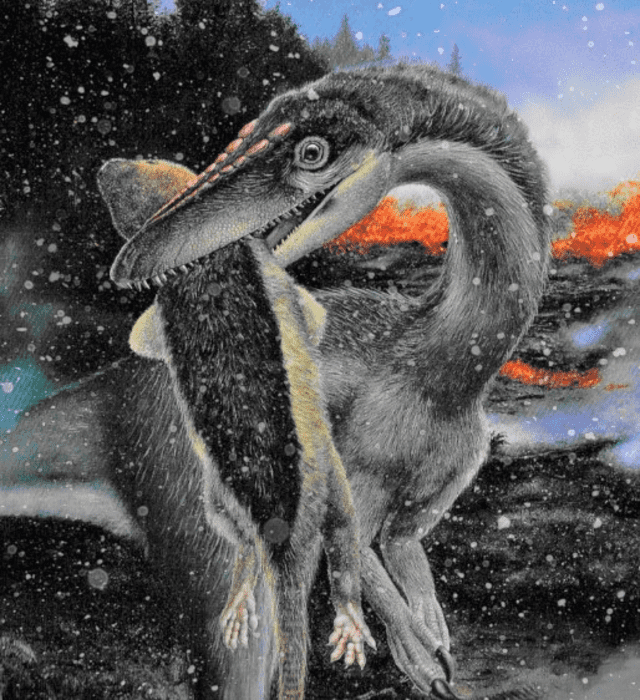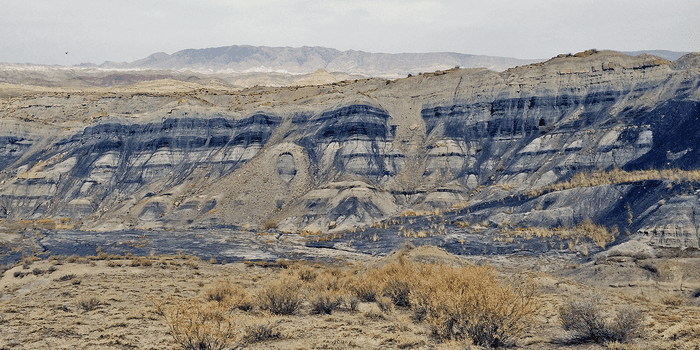
Paleontologists often talk a lot about how dinosaurs met their tragic end in an epic fashion about 65 million years ago when a giant asteroid slammed into Earth off the coast of Mexico. But while the story of their downfall is rather well pieced together, the same can’t be said about the murky period when they began to rise to the top from their very humble beginnings. What we do know is that they profited from another, much earlier mass extinction from about 200 million years ago that wiped out most of the reptiles that dominated the land — and a new study that performed excavations in the desert of western China suggests that dinosaurs were able to survive the volcanic winters during the late Triassic and early Jurassic thanks to primitive plumage and other adaptations they gained by living in high latitudes.
Not so naked after all
Hollywood movies and even many textbook illustrations depict dinosaurs as naked beasts that roam through warm and luxuriant rain forests. However, in the Triassic (252-201 million years ago), when they were still relegated to a minor role in the food chain, many dinosaurs lived in higher latitudes, some well above the Arctic Circle. According to new research that uncovered fossilized footprints and rock fragments that bear telltale signs of ice, some Triassic dinosaurs endured freezing conditions. There wasn’t much they could do about it since all the ‘good’ spots were already taken, but this ability to endure the cold would come in very handy later on.
Granted, the world back then looked nothing like today. The planet’s landmass was all joined together in a supercontinent called Pangaea. The concentration of carbon dioxide in the atmosphere hovered at around 2,000 parts per million – about five times higher than today’s levels. As such, the surface temperatures were much higher than they are today, but life had time to adapt because unlike the global warming we’re experiencing today, this shift in greenhouse gases in the atmosphere did not come overnight, on a geological timescale.
The hotter tropical and subtropical regions of the supercontinent were dominated by mammal-like reptiles and archosaurs (represented today by birds and crocodylians) that lived in vast conifer forests — flowering plants and grasses had yet to evolve. The understory of these conifers would have been occupied by shrubs and woody vines, where all sorts of weird animals lingered, such as the long-necked Tanystropheus or chameleon-like drepanosaurs, which had a claw on the end of their tails. Not that many dinosaurs though, which only appeared about 240 million years ago. The few dinosaurs that existed were as varied in color as modern birds and had just as varied behaviors, but none was as large as the giants of the Late Jurassic and Cretaceous, such as the iconic T. rex and Titanosaurs.

Though ecological niches would trade hands back and forth with occasional episodes of climate change, things were pretty stable. Everybody generally knew their place — that’s until around 200 million years ago when Earth experienced a new mass extinction event.
We don’t know much about what happened but the consensus among scientists is that Pangea started to break apart, opening up what we now call the Atlantic Ocean. In the process, the tectonic shifts triggered massive volcanic activity that could have lasted for centuries. These eruptions released even more carbon dioxide into the atmosphere, turning the oceans more acidic and causing sea levels to rise dramatically. Virtually all ancient reptiles went extinct, apart from dinosaurs, pterosaurs, and crocodiles. Marine life was almost completely obliterated by the massive ocean acidification and low oxygen conditions.
But although the huge amounts of greenhouse gases would eventually heat the global climate tremendously, the volcanic activity also released sulfur dioxide and other aerosols that blocked the sun. Before the never-ending scorching heat, there was an equally deadly global winter, and it just so happened that dinosaurs were better positioned and adapted to withstand the cataclysm.
“Dinosaurs, both living (birds) and extinct largely owed their success to their insulation that allowed them to survive many episodes of cold and live in persistently cold environments. Specifically, all large naked competitors of dinosaurs on land became extinct during the volcanic winters that resulted from the giant eruptions at the end of the Triassic, allowing dinosaurs to become ecologically dominant globally,” Paul Olsen, a geologist at Columbia University’s Lamont-Doherty Earth Observatory, and lead author of the new study, told ZME Science.
“We got dinosaurs all wrong, they are and were not denizens of just tropical environments, they are fundamentally cold-adapted animals, from their very beginnings.”
The reptiles are dead. Long live the dinosaurs!
Olsen and colleagues found fine-grained sandstone and siltstone formations at the bottom of an ancient lake in the Junggar Basin of China. These sediments formed around 206 million years ago, trapping information about the ancient environmental conditions through the mass extinction and beyond. During that time, the excavation site lay about 71 degrees north, well above the Arctic Circle.

These sediments revealed dinosaur footprints, showing that they were active in the region and likely fared well. But the researchers also found relatively large pebbles mixed with normally fine sediments, pebbles that should have no business being there, so far from the shoreline. The only viable explanation is that the pebbles were transported by ice, which moved the rocks — known as ice-rafted debris (IRD) — to the bottom of the lake when it melted, mixing with the fine sediments.
“The sediments are solid rock and difficult to break down to make comparisons with modern environments, a problem compounded by how hard it is to accurately measure grain size over four orders of magnitude in one sample. These problems were, fortunately, overcome early by Clara Chang a graduate student at Columbia and co-author of the paper,” Olsen said. “We suspect many researchers think we have not surmounted those challenges. However, with persistence and by consistently relying on Occam’s razor, often given the more technical term of parsimony, in our reasoning, we believe we have.”
“On our very first day in the field in the Junggar Basin, at the very first stop, we saw what we eventually figured out was lake-ice rafted sand grains and pebbles in the very first piece of rock we looked at. We said, “That isn’t right” and we stood right there and argued for several hours about what it meant. In the weeks to follow we found similar lake-ice rafted sand grains and pebbles in many layers,” Olsen wrote in an email.
This is essentially the first evidence that dinosaurs could withstand freezing temperatures. They did so thanks to thermal insulation provided by primitive feathers. Furthermore, there is solid evidence that many dinosaurs were warm-blooded like us, unlike the cold-blooded reptiles that depended on the sun to regulate their temperature and metabolisms. So when the global chill came, the dinosaurs were ready — and they hastily moved in to take over once everyone else perished. At least, that’s what this study suggests. Many will disagree, but we’re finally inching closer to understanding how dinosaurs become so hugely successful.
The dinosaurs are dead. Long live the mammals!
This was the dawn of the age of dinosaurs, and they had a pretty good run. That’s until, you know, that asteroid happened. But in the aftermath of yet another great extinction, came the age of the mammals and, ultimately, the age of mankind. You probably see a pattern here: nature is in equilibrium and the ecosystem is dominated by one particular group, until some global disaster happens and the entire world order goes through an upheaval. The question is who now lurking in the shadows will inherit the Earth after we’re all long dead?
“They [dinosaurs] were insulated from the cold by proto-feathers and could survive the cold of the volcanic winters at the end of the Triassic, 202 million years ago. The same thing was true for the small dinosaurs (birds) during the impact winter at the famous K-T (Cretaceous–Paleogene) boundary 66 million years ago when all large animals went extinct because of a shut-off of light and extreme cold. Both mass extinctions occurred because of unusual cold events caused by physical phenomena, but the K-T also involved darkness that affected large animals because it cut off the large amounts of food they needed,” Olsen said.
The findings appeared in the journal Science Advances.






